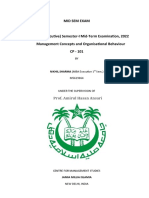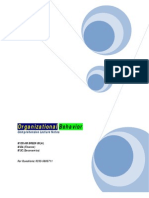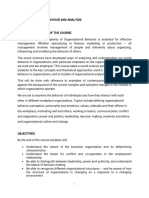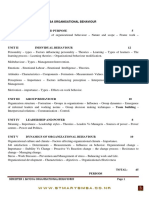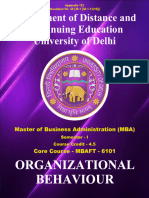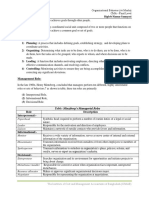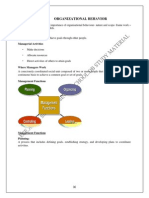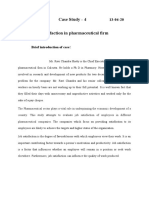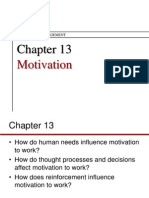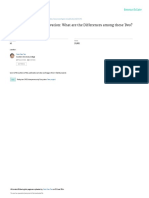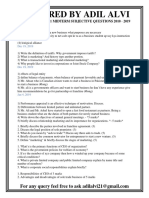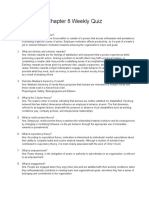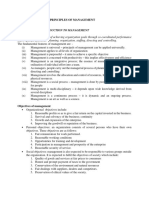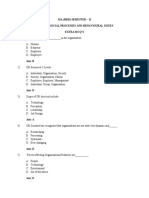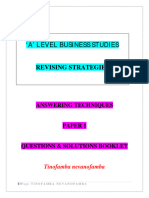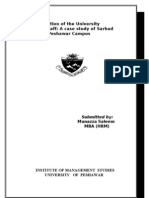OB - MBA - Nutshell
Uploaded by
Sanskar wadhwaOB - MBA - Nutshell
Uploaded by
Sanskar wadhwa1
ORGANISATIONAL BEHAVIOUR
MBA – SEMESTER II
MODULE 1: INTRODUCTION TO ORGANIZATIONAL BEHAVIOUR
1. Explain the work of the managers according to the four different categories of activities at
workplace.
i. Planning: Defining goals, establishing strategies to achieve goals, developing plans to
integrate and coordinate activities
ii. Organizing: Arranging and structuring work to accomplish organizational goals
iii. Leading: Working with and through people to accomplish goals
iv. Controlling: Monitoring, comparing and correcting work.
2. Demonstrate the importance of interpersonal skills in the workplace.
i. Responsible for motivation
ii. Helpful in direction
iii. Maintain network with cross functional teams
iv. Transmits information from outsiders and employees
v. Respecting others viewpoints
vi. Take corrective actions
vii. Represents organization at major negotiations
viii. Manages routine duties that are social in nature
3. Discuss Henry Mintzberg’s 10 Managerial Roles.
Interpersonal
i. Figurehead – As a manager, you have social, ceremonial and legal responsibilities. You're
expected to be a source of inspiration. People look up to you as a person with authority, and as a
figurehead. (Build Reputation/ Empathy/ Role Model)
ii. Leader – This is where you provide leadership for your team, your department or perhaps your
entire organization; and it's where you manage the performance and responsibilities of everyone
in the group. (Leadership Skills/ Emotional Intelligence)
iii. Liaison – Managers must communicate with internal and external contacts. You need to be able
to network effectively on behalf of your organization. (Professional Networking)
Informational
iv. Monitor – In this role, you regularly seek out information related to your organization and
industry, looking for relevant changes in the environment. You also monitor your team, in terms
of both their productivity, and their well-being. (Gather Info/ Up to date with Industry)
v. Disseminator – This is where you communicate potentially useful information to your colleagues
and your team. (Team Briefing/ Writing Skills)
vi. Spokesperson – Managers represent and speak for their organization. In this role, you're
responsible for transmitting information about your organization and its goals to the people
outside it. (Great at Presentation)
Decisional
vii. Entrepreneur – As a manager, you create and control change within the organization. This means
solving problems, generating new ideas, and implementing them. (Change Management/
Creativity/ Learn What not to do when implementing change)
Compiled by Dr. Devpriya Dey for MBA students.
2
viii. Disturbance Handler – When an organization or team hits an unexpected roadblock, it's the
manager who must take charge. You also need to help mediate disputes within it. (Conflict
Resolution/ Manage Emotion in the team)
ix. Resource Allocator – You'll also need to determine where organizational resources are best
applied. This involves allocating funding, as well as assigning staff and other organizational
resources. (Manage Budget/ Cut Costs/ Prioritize)
x. Negotiator – You may be needed to take part in, and direct, important negotiations within your
team, department, or organization. (Win-Win Negotiation)
4. Explain the three key management skills for a manager.
5. Identify the major behavioral science disciplines that contribute to organizational behavior.
i. Psychology: attempts to explain human behavior in a particular situation and predicts actions
of individuals
ii. Social Psychology: blends concepts from psychology and sociology and that focuses on the
influence of people on one another
iii. Sociology: impact of culture on group behavior
iv. Anthropology: human behavior in various cultural and environmental frameworks
v. Political science - The study of the behaviour of individuals and groups within a political
environment
6. Discuss the challenges and opportunities of organizational behavior.
i. Economic Pressures
ii. Continuing Globalization
iii. Workforce Demographics
iv. Workforce Diversity
v. Customer Service
vi. People Skills
vii. Social Media
viii. Employee wellbeing at work
ix. Positive work environment
x. Ethical Behaviour
7. Explain the basic organizational behavior model/ what are the three levels of analysis in
organizational behavior model?
i. Individual Level: Attitude, Perception, Personality
ii. Group Level: Motivation, Leadership, Power, Politics
iii. Organizational Level: Organizational change, Organizational development, Organizational
Culture
Compiled by Dr. Devpriya Dey for MBA students.
3
8. What is diversity? Describe the two major forms of workplace diversity.
DIVERSITY & INCLUSION (DE&I) is the practice or quality of including or involving people from
a range of different social and ethnic backgrounds and of different genders, sexual orientations.
i. Surface Level Diversity: Age, Race, Gender, Ethnicity, Religion, Disability status
ii. Deep Level Diversity: Personality, Values, Attitudes, Work Preferences
9. Describe how organizations manage diversity effectively.
i. Attracting, Selecting, Developing and Retaining diverse employees
ii. Diversity in Groups
iii. Expatriate Adjustment- An expatriate is an individual who resides outside their native
country, either temporarily or for work reasons.
iv. Effective Diversity Programs
MODULE 2: ATTITUDES, EMOTIONS, PERSONALITY AND VALUES
10. What is attitude? What is the difference between attitude and behavior? Contrast the three
components of an attitude.
Attitude is a manner of thinking, feeling, or behaving that reflects a state of mind or disposition.
While attitude involves mind's predisposition to certain ideas, values, people, systems, institutions;
behaviour relates to the actual expression of feelings, action or inaction orally or/and through body
language.
i. Affective: Emotion/feeling associated with the attitude. (Likes/dislikes) E.g.: I don’t like my
boss.
ii. Cognitive: Belief associated with the attitude based on experience, misunderstanding or
rumors. E.g.: My boss is unfair
iii. Behavioral: The way that an individual intends to behave towards an object or a situation.
E.g.: I am going to request a transfer or resign.
11. Compare the major job attitudes.
i. Job Satisfaction & Job Involvement
Compiled by Dr. Devpriya Dey for MBA students.
4
Job Satisfaction refers to an individual's overall feelings and attitudes towards their
job. It involves evaluating various aspects of the job, such as pay, working conditions,
co-workers, and opportunities for growth. A high level of job satisfaction indicates
that an individual has positive feelings about their work.
Job Involvement refers to the degree to which an individual is emotionally invested in
and engaged with their job. It reflects the importance and centrality of work in an
individual's life. Highly involved employees are deeply interested and committed to
their work and are likely to experience greater job satisfaction.
ii. Organizational Commitment- Organizational Commitment refers to an individual's
psychological attachment and loyalty to the organization they work for. It involves a sense of
identification with the organization's goals and values, a desire to stay with the organization,
and a willingness to exert effort to contribute to its success. High organizational commitment
is associated with increased job satisfaction and job involvement.
iii. Perceived Organizational Support- Perceived Organizational Support (POS) refers to an
employee's perception of how much the organization values their contributions and cares
about their well-being. It includes support from supervisors, coworkers, and the organization
as a whole. When employees perceive high levels of support, they are more likely to have
positive job attitudes, including higher job satisfaction, commitment, and involvement.
iv. Employee Engagement- Employee Engagement is the extent to which employees are
emotionally invested in and committed to their work and the organization. Engaged
employees are enthusiastic, motivated, and willing to go the extra mile to contribute to
organizational success. Employee engagement encompasses various aspects, including job
satisfaction, involvement, commitment, and a sense of purpose and fulfillment in their work.
12. Differentiate between emotions and moods. What are the sources of emotions and moods?
Sources of Emotions: Personality, Age, Gender, Time of the day, Day of Week, Weather, Stress, Social
Activities, Sleep, Exercise, Blood sugar levels
Compiled by Dr. Devpriya Dey for MBA students.
5
13. What is emotional labor? What is emotional intelligence?
i. Emotional Labour: It is an employee’s expression of organizationally desired emotions during
interpersonal transactions at work. Emotional Labour is a key component of effective job
performance.
ii. Emotional intelligence (EI) is a person’s ability to (a) perceive emotions in the self and
others, (b) understand the meaning of these emotions, and (c) regulate his or her emotions
accordingly.
14. Discuss the organizational behavior applications of emotions and moods.
i. Selection: Emotions and moods can impact the selection process by influencing the
decision-making of both candidates and interviewers. For candidates, positive emotions and
moods can enhance their performance and presentation during interviews, increasing their
chances of being selected. Similarly, interviewers' moods and emotions can affect their
judgments and perceptions of candidates.
ii. Decision Making: Emotions and moods can influence decision-making processes. Positive
moods and emotions can lead to more creative and flexible decision-making, while negative
moods and emotions may hinder decision-making and result in biases or risk aversion.
Emotionally intelligent individuals can effectively manage their own and others' emotions to
make better decisions.
iii. Creativity: Emotions and moods have a significant impact on creativity. Positive
emotions can enhance creative thinking and problem-solving abilities, while negative
emotions may restrict creativity. Creating a positive and supportive work environment that
fosters positive moods can promote creativity and innovation among employees.
iv. Motivation: Emotions and moods can influence employee motivation. Positive emotions,
such as happiness and enthusiasm, can enhance motivation levels and increase productivity.
Conversely, negative emotions, such as frustration or anger, can lead to demotivation and
decreased performance. Understanding and managing emotions in the workplace can help in
maintaining a motivated workforce.
v. Leadership: Emotions and moods are critical for effective leadership. Leaders who can
understand and manage their own emotions and the emotions of their team members can build
positive relationships, enhance employee satisfaction, and motivate their teams. Emotionally
intelligent leaders can create an atmosphere of trust, open communication, and support, which
contributes to better organizational outcomes.
vi. Negotiation: Emotions and moods play a crucial role in negotiation processes.
Understanding and managing emotions can help negotiators assess the emotional state of the
other party and adjust their strategies accordingly. Emotional intelligence enables negotiators
to handle conflicts, build rapport, and find mutually beneficial solutions.
vii. Job Attitudes: Emotions and moods significantly influence job attitudes, such as job
satisfaction, involvement, and commitment. Positive emotions and moods contribute to
positive job attitudes, while negative emotions and moods can lead to dissatisfaction and
disengagement. Organizations can focus on creating a positive emotional climate to foster
desirable job attitudes.
viii. Safety and Injury at Work: Emotions and moods can impact safety behaviors and the
likelihood of workplace injuries. Positive moods and emotions contribute to increased
Compiled by Dr. Devpriya Dey for MBA students.
6
attention, focus, and adherence to safety protocols, reducing the likelihood of accidents.
Negative emotions, distractions, or stress can impair safety-related behaviors, leading to an
increased risk of workplace injuries.
ix. Negative Workplace Behavior: Emotions and moods can influence negative workplace
behaviors, such as aggression, bullying, or sabotage. Negative emotions, such as anger,
frustration, or resentment, can escalate conflicts and contribute to toxic work environments.
Managing emotions and promoting positive moods can help mitigate negative workplace
behavior and foster a harmonious workplace culture.
15. Define personality. What are the determinants of personality?
Personality as the sum total of the ways an individual reacts to and interacts with others.
Personality Determinants:
i. Heredity: Heredity refers to the genetic factors that influence an individual's personality traits.
Certain traits and characteristics can be inherited from biological parents, such as temperament,
intelligence, and predispositions to certain behaviors. However, it is important to note that while
genetics provide a foundation, environmental factors also play a significant role in shaping
personality.
ii. Culture: Culture encompasses the shared beliefs, values, norms, customs, and practices of a
particular group or society. Culture has a profound influence on personality development as
individuals learn and internalize cultural norms and expectations. Cultural values and socialization
processes shape an individual's attitudes, beliefs, and behaviors, contributing to the formation of their
personality.
iii. Family: The family environment and dynamics significantly impact personality development.
Parents, siblings, and other family members serve as role models and sources of socialization.
Parenting styles, familial relationships, and the quality of attachment formed in childhood can shape
personality traits and behaviors. Family experiences and interactions contribute to the development of
self-esteem, values, and interpersonal skills.
iv. Social: Social factors, such as peer groups, friends, and social networks, influence personality.
Interactions with others, social norms, and social experiences contribute to the development of
personality traits and behaviors. Peer pressure, social support, and socialization within different social
contexts shape an individual's self-concept, identity, and social skills.
v. Situational: Situational factors refer to the immediate environment and circumstances that
influence behavior and expressions of personality. Different situations can elicit different responses
and behaviors from individuals. For example, a person may exhibit different personality traits and
behaviors at work compared to their behavior in a social setting. Situational factors, such as the
presence of authority figures, group dynamics, and environmental stimuli, can influence how
individuals express their personality.
16. Discuss the Myers-Briggs Type Indicator in detail.
It is a 100-question personality test that asks people how they usually feel or act in situations.
Respondents are classified as extraverted or introverted (E or I), sensing or intuitive (S or N), thinking
or feeling (T or F), and judging or perceiving (J or P).
Compiled by Dr. Devpriya Dey for MBA students.
7
i. Extraverted (E) Versus Introverted (I). Extraverted individuals are outgoing, sociable, and
assertive. Introverts are quiet and shy.
ii. Sensing (S) Versus Intuitive (N). Sensing types are practical, prefer routine and order, and
focus on details. Intuitives rely on unconscious processes and look at the “big picture.”
iii. Thinking (T) Versus Feeling (F). Thinking types use reason and logic to handle problems.
Feeling types rely on their personal values and emotions.
iv. Judging (J) Versus Perceiving (P). Judging types want control and prefer order and structure.
Perceiving types are flexible and spontaneous.
These classifications describe personality types by identifying one trait from each of the four pairs.
For example, Introverted/Intuitive/Thinking/Judging (INTJ) people are visionaries with original
minds and great drive. They are skeptical, critical, independent, determined, and often stubborn
17. Explain the Big Five Personality Model and discuss how it influence organizational behavior
criteria?
i. Extraversion: The extraversion dimension captures our comfort level with relationships.
Extraverts tend to be gregarious, assertive, and sociable.
ii. Agreeableness. The agreeableness dimension refers to an individual’s propensity to accept
others. Highly agreeable people are cooperative, warm, and trusting.
iii. Conscientiousness. The conscientiousness dimension is a measure of reliability. A highly
conscientious person is responsible, organized, dependable, and persistent.
iv. Emotional stability. The emotional stability dimension—often labelled by its converse,
neuroticism—taps a person’s ability to withstand stress. People with positive emotional
stability tend to be calm, self-confident, and secure
v. Openness to experience. The openness to experience dimension addresses range of interests
and fascination with novelty. Open people are creative, curious, and artistically sensitive.
18. Explain and contrast between Terminal Values, Instrumental Values.
Values are basic and fundamental beliefs that guide or motivate attitudes or actions.
Terminal Values – goals that we work towards and view as most desirable. They are goals that
one would like to achieve during their lifetime. E.g. A comfortable life.
Compiled by Dr. Devpriya Dey for MBA students.
8
Instrumental Values – deals with views of acceptable modes of conduct like being ethical,
ambitious. These are preferable modes of behavior, or means of achieving the terminal values.
E.g Responsible
19. Write a short note on generational values and international values.
Generational values:
International values: Values vary across cultures, i.e. people’s values in one nation tend to differ from
those in another; however, there is substantial variability in values within a culture.
Countries across the world differ on the 5 values based on the Hofstede Framework:
i. Power distance: Power distance describes the degree to which people in a country accept that
power in institutions and organizations is distributed unequally. A high rating on power
distance means that large inequalities of power and wealth exist and are tolerated in the
culture
ii. Individualism versus collectivism: Individualism is the degree to which people prefer to act as
individuals rather than as members of groups and believe in individual rights above all else.
Collectivism emphasizes a tight social framework in which people expect others in groups of
which they are a part to look after them and protect them.
iii. Masculinity versus femininity: masculinity is the degree to which the culture favours
stereotypically masculine values such as achievement, power, and control, as opposed to
stereotypically feminine values such as social harmony
iv. Uncertainty avoidance: In cultures that score high on uncertainty avoidance, people have an
increased level of anxiety about uncertainty and ambiguity and use laws and controls to
reduce uncertainty. People in cultures low on uncertainty avoidance are more accepting of
ambiguity, are less rule-oriented, take more risks, and more readily accept change.
v. Long-term versus short-term orientation: People in a culture with long-term orientation look
to the future and value thrift, persistence, and tradition. In a short-term orientation, people
value the here and now; they accept change more readily and don’t see commitments as
impediments to change
20. What are the implication of major job attitudes for managers?
i. Recognize that attitudes have cognitive, affective, and behavioural components. Managers
looking to foster attitudinal change should focus on behaviours but also address cognition and
affect.
Compiled by Dr. Devpriya Dey for MBA students.
9
ii. Pay attention to your employees’ job satisfaction levels as determinants of their performance,
organizational citizenship, turnover, absenteeism, and withdrawal behaviours.
iii. Measure employee job attitudes objectively and at regular intervals in order to determine how
employees are reacting to their work.
iv. Consider the fact that high pay alone is unlikely to create a satisfying work environment. Pay
attention to social, justice, and equity concerns to maximize workers’ satisfaction.
MODULE 3: PERCEPTION, MOTIVATION, GROUP BEHAVIOUR
21. What is perception? Explain the factors that influence perception.
Perception is a process where individuals select, organize & interpret their sensory
stimulation into meaningful information.
Three factors influence perception.
i. Perceiver
ii. Target
iii. Situation (situation in which the perception is made)
22. What attribution theory? Discuss the use of attribution theory for making judgment about
behavior.
An attempt to explain the ways we judge people differently depending on the meaning we attribute to
the behaviour, such as determining whether an individual’s behavior is internally or externally caused.
Internally caused behaviours are those an observer believes to be under the personal control of another
individual. Externally caused behaviour is what we imagine the situation forced the individual to do.
That determination depends largely on three factors:
(a) Distinctiveness: whether an individual displays different behaviour in different situations
(b) Consensus: if everyone, who faces a similar situation responds in the same way
(c) Consistency: does the person respond the same way over time
Use of attribution theory for making judgment about behavior
Compiled by Dr. Devpriya Dey for MBA students.
10
23. Discuss the common shortcuts in judging others. Throw light upon the specific applications of
shortcuts in organizations.
Common shortcuts in judging others
i. Selective Perception: When people tend to see only a few qualities and judge the person
completely
ii. Halo Effect: Judging an individual positively only on one particular trait/characteristics
iii. Horn Effect: Judging an individual negatively only on one particular trait/characteristics
iv. Contrast Effects: Most recent information dominates perception
v. Golem Effects: If an individual’s belief is negative
vi. Stereotyping: When people believe that all members of a specific group will have common
characteristics.
Applications of shortcuts in organizations
i. Employment interview: Interviewers make perceptual judgements that are often inaccurate
and draw early impressions.
ii. Performance Expectations: Individual’s behavior is determined by others expectation. People
holding a high expectation of another tend to improve that individual performance.
iii. Performance Evaluations: Many parameters of the performance on the job is evaluation
subjectively rather objectively.
24. Explain the steps in rational decision-making model. How individual differences and
organizational constraints affect decision-making?
i. Define the problem.
ii. Identify the decision criteria.
iii. Allocate weights to the criteria.
iv. Develop the alternatives.
v. Evaluate the alternatives.
vi. Select the best alternative
Influence on decision-making:
Individual Differences:
i. Personality
ii. Gender
iii. Mental ability
iv. Cultural Differences
Compiled by Dr. Devpriya Dey for MBA students.
11
Organizational constraints
i. Performance Evaluation Systems: Managers are influenced by the criteria on which they are
evaluated.
ii. Reward Systems: The organization’s reward system influences decision makers by suggesting
which choices have better personal payoffs
iii. Formal Regulations: Freedom of choice gets restricted by policies
iv. System-imposed Time Constraints: Decisions made within a deadline might get comprised
due to time constraints
v. Historical precedents: Decisions made in the past are like ghosts and constrain current
choices.
25. What are the three key elements of motivation? Discuss the early theories of motivation i.e.
(Hierarchy of needs theory/ Two factors Theory/ Mc Clelland’s Theory of Needs)
Motivation as the processes that account for an individual’s intensity, direction, and persistence of
effort toward attaining a goal.
i. Intensity describes how hard a person tries
ii. Direction: High intensity is unlikely to lead to favourable job-performance outcomes unless
the effort is channelled in a direction that benefits the organization.
iii. Persistence: This measures how long a person can maintain effort.
Abraham Maslow’s hierarchy of needs
i. Physiological. Related to hunger, thirst, shelter, sex, and other bodily needs.
ii. Safety. Security and protection from physical and emotional harm.
iii. Social: Affection, belongingness, acceptance, and friendship.
iv. Esteem. Internal factors such as self-respect, autonomy, and achievement, and external factors
such as status, recognition, and attention.
v. Self-actualization. Drive to become what we are capable of becoming; includes growth,
achieving our potential, and self-fulfilment
Douglas McGregor’s Theory X and Theory Y
i. Theory X: Employees work as little as possible, lack ambition, dislike responsibility, resistant
to change. Therefore, they need to be controlled, pressurized & bribed. (Negative Motivation)
ii. Theory Y: Employees are willing to work; they are creative & self-directed. Hence, the
management must arrange conditions & methods of operation so that employees can achieve
their own goals best by directing their own efforts towards org objectives. (Positive
Motivation)
Herzberg’s Two-factor theory
i. Hygiene Factors CANNOT MOTIVATE but ELIMINATE DISSATISFACTION. Hygiene
Factors: Salary, Company Policies, Working Environment and Job Security
ii. If motivational factors are not there, the effect is neutral, but if present then it will result into
motivation. Motivational Factors: Job Enrichment, Career Growth and Recognition
Mc Clelland’s Theory of Needs
i. Need for Achievement: Strive to Succeed
ii. Need for Power: Seek Influence, Attention & recognition
iii. Need for Affiliation: Relationship, Love & Affection and Group Membership
Compiled by Dr. Devpriya Dey for MBA students.
12
26. Describe how job characteristics model motivates by changing the work environment.
The job characteristics model (JCM) describes jobs by five core dimensions
i. Skill variety is the degree to which a job requires different activities using specialized skills
and talents
ii. Task identity is the degree to which a job requires completion of a whole and identifiable
piece of work.
iii. Task significance is the degree to which a job is perceived to affect the lives or work of other
people.
iv. Autonomy is the degree to which a job provides the worker freedom, independence, and
discretion in scheduling work and determining the procedures for carrying it out.
v. Feedback is the degree to which carrying out work activities generates direct and clear
information about your own performance.
The JCM proposes that individuals obtain internal rewards when they learn (knowledge of results) that
they personally have performed well (experienced responsibility) on a task they care about (experienced
meaningfulness).2 The more these three psychological states are present, the greater will be employees’
motivation, performance, and satisfaction, and the lower their absenteeism and likelihood of leaving.
Individuals with a high growth need are likely to experience the critical psychological states when their
jobs are enriched—and respond to them positively.
27. Compare the main ways that jobs can be re-designed.
i. Job rotation: the periodic shifting of an employee from one task to another with similar skill
requirements at the same organizational level
ii. Job enrichment: It is a method of motivating employees where a job is designed to have
interesting and challenging tasks, which can require more skill and can increase pay. The
purpose of job enrichment is to expand the tasks that each employee performs, allow them to
perform tasks in different ways, and ultimately give them more control over their work. This
makes work more stimulating and helps to motivate employees to do their best work.
iii. Relational Job Design: Managers design the work in such a way so that employees are
motivated to promote the well-being of the organization’s beneficiaries (customers, clients,
patients, and employees).
Compiled by Dr. Devpriya Dey for MBA students.
13
iv. Flexitime: Claimed benefits include reduced absenteeism, increased productivity, reduced
overtime expenses, reduced hostility toward management, reduced traffic congestion around
work sites on commute paths, elimination of tardiness, and increased autonomy and
responsibility for employees—any of which may increase employee job satisfaction
v. Job Sharing: Job sharing allows two or more individuals to split a traditional 40-hour-a-week
job. Job sharing allows an organization to draw on the talents of more than one individual for
a given job. It opens the opportunity to acquire skilled workers—for instance, parents with
young children and retirees—who might not be available on a full-time basis. From the
employee’s perspective, job sharing can increase motivation and satisfaction.
vi. Telecommuting: Telecommuting has several potential benefits: a larger labour pool from
which to select, higher productivity, improved morale, and reduced office-space costs. A
positive relationship exists between telecommuting and supervisor performance ratings.
28. What is social identity theory? How do we classify the groups?
Social identity is a person's sense of who they are based on their group membership(s).
Types of Groups:
i. Informal: Natural formation in work environment in response to the need for social contact
ii. Interest Group: who have a mutual interest e.g.: working mothers
iii. Friendship Group: who have common characteristics e.g.: marital status, sports
iv. Reference Group: any group with whom an individual identifies for the purpose of forming
opinions or making decisions. Such groups act as a frame of reference to which people always
refer to evaluate their achievements, their role performance, aspirations and ambitions.
v. Formal: Deliberately created to perform a specific task E.g.: R/d lab, mgmt. team
vi. Standing Task Group: consists of a supervisor who exercises formal authority over
subordinates
vii. Task Group: a temporary formal group that is created to solve specific problem
29. Discuss the group properties. Explain the group decision-making techniques.
Group Properties:
i. Roles: parts played by group members
ii. Norms: rules and expectations (acceptable standards of behavior shared by their members)
iii. Status: prestige of group membership
iv. Group Size: size of a group affect the group’s overall behavior (Social Loafing: the tendency
for individuals to give less effort when working collectively than alone.)
v. Cohesiveness: sense of belonging
vi. Diversity: the degree to which members of the group are similar to, or different from, one
another.
Group decision-making techniques
i. Interacting groups: Typical groups where members interact with each other face to face.
ii. Brainstorming: A idea generation process that specifically encourages alternatives.
iii. Nominal Group techniques: small groups of individuals systematically present & discuss their
ideas before privately voting their preferred solutions.
iv. Electronic Meeting
v. Stepladder Technique: Adding new members to a group one at a time and requiring each to
present his/her ideas independently to a group that already has discussed the problem at hand.
Compiled by Dr. Devpriya Dey for MBA students.
14
30. Discuss five-stage model of group development.
i. Forming: (Awareness): Lot of uncertainty, focus on understanding the goal, work out
procedures for performing the task, decides on structure, leadership
ii. Storming: (Conflict): Mixture of expressions, conflicts regarding priorities of goals,
responsibilities of each member
iii. Norming: (Cooperation): Group Cohesiveness, share info, shows acceptance, compromising
decisions
iv. Performing: (Productivity): Group is fully operational, high productivity & helps each other
v. Adjourning: (Separation): Group disbandon after the task, fulfillment of task performance,
feeling of sadness at the loss of friendship
31. Write a short note on a) punctuated equilibrium model b) groupthink c) group shift
a) Punctuated equilibrium model: It is an alternative model for temporary groups with deadlines.
Beginning of Group Discussions (First half): Groups makes plan but accomplishes little.
Half to deadline: Group makes changes
End (Second half): Group makes the final changes & reaches the deadline
b) Groupthink is a psychological phenomenon that occurs within a group of people in which the
desire for harmony or conventionality in the group results in an irrational or dysfunctional
decision-making outcome. Members of a group make decisions based on the pressure that they
get from the group.
c) Group shift refers to a condition where the position of an individual in the group changes to adopt
an extreme position due to the influence of the group. When people are in groups, they make
decisions about risk differently from when they are alone.
32. What are the implication of motivation for the managers?
i. Make sure extrinsic rewards for employees are not viewed as coercive, and recognize the
importance of intrinsic motivators that appeal to employees’ desires for autonomy,
relatedness, and competence.
ii. Consider goal-setting theory: Within reason, clear and difficult goals often lead to higher
levels of employee productivity.
iii. In accordance with self-efficacy theory, efforts you make to help your employees feel
successful in completing tasks will result in their increased motivation.
iv. As suggested by justice theory, ensure that employees feel treated; sensitivity to processes
and interactions are particularly important when rewards are distributed unequally.
v. Expectancy theory: Employees are more motivated to engage in behaviours they think they
can perform, which in turn lead to valued rewards.
MODULE 4: LEADERSHIP, POWER & POLITICS
33. Contrast between the trait theory and behavioral theory of leadership.
Trait theory of leadership: Leaders have certain traits. They are born & not made. If these traits are
identified & measured, organizations can select leaders based on these traits.
Trait theory is a function of these inborn traits like – Intelligence – Perception – Socio-economic
status – Need for self-actualization – Self-assurance – Understanding – High motivation – Maturity –
Understanding of interpersonal factors
Compiled by Dr. Devpriya Dey for MBA students.
15
Behavioral theory of leadership: It is based on what leaders do & not on what qualities/traits leaders
have. For e.g. Blake & Mouton’s managerial grid theory where balancing the task (concern for
production) & people (concern for employees) orientation with a 9-grid model exists.
34. Write short notes on the contingency theories of leadership i.e. a) Fiedler Model b) Situational
Leadership Theory c) Path Goal Theory
Fielder‘s theory of leadership (Fred E.Fielder):
There is not one best style of leadership.
Leaders' effectiveness depends on the natural Leadership style and the Situational
favorableness
Fiedler identified two different styles of leadership behavior
o Relationship Oriented Leader
o Task Oriented Leader
Favorable situation depends on three situational variables
o Leader member relations (trust factor)
o Task structure (clarity of tasks with the team)
o Leader position power (level of authority you command)
Path-goal theory of leadership (Robert House)
States that leader‘s job is to create a work environment (through structure, support & rewards) that
helps employees to reach the organisational goals
Situational Leadership Theory
The Situational Leadership model addresses four types of leadership styles
Compiled by Dr. Devpriya Dey for MBA students.
16
Telling or Directing
Coaching
Supporting
Delegating
35. Write short notes on the contemporary theories of leadership i.e. a) LMX Theory b)
Charismatic Leadership c) Transactional Leadership d) Transformational leadership e)
Authentic leadership
Charismatic leadership (CL): It is a type of leadership that combines charm, interpersonal connection, and
persuasiveness to motivate others.
i. This is done by tapping into their team members’ emotions, creating a sense of trust, passion,
and purpose greater than themselves.
ii. CLs influence others with their personality and charm.
iii. CLs encourage others using their strong communication skills and listening skills
E.g., Mahatma Gandhi, Barack Obama
Key Characteristics of a Charismatic Leader
i. Vision and articulation. Has a vision—expressed as an idealized goal—that proposes a future
better than the status quo and is able to clarify the importance of the vision in terms that are
understandable to others.
ii. Personal risk. Willing to take on high personal risk, incur high costs, and engage in
selfsacrifice to achieve the vision.
iii. Sensitivity to follower needs. Perceptive of others’ abilities and responsive to their needs and
feelings.
iv. Unconventional behaviour. Engages in behaviours that are perceived as novel and counter to
norms
Transactional Leadership: Transactional leadership is primarily based on processes and control, and
requires a strict management structure
Compiled by Dr. Devpriya Dey for MBA students.
17
i. Transactional leadership looks at how to get things done
ii. Transactional leaders focus on goals
iii. Use Rewards and Punishment for Motivation
Transformational leadership: Transformational Leadership focuses on inspiring others to follow,
i. They have high degree of coordination, communication, and cooperation.
ii. Transformation leadership looks at how to motivate people to do things.
iii. Transformation leaders focus on vision
iv. Use Charisma and Enthusiasm for motivation
Authentic leadership: Authentic leadership focuses on the moral aspects of being a leader. Authentic leaders
know who they are, know what they believe in, and act on those values and beliefs openly and candidly. Their
followers consider them ethical people. The primary quality produced by authentic leadership is trust.
Authentic leaders share information, encourage open communication, and stick to their ideals. The result:
People have faith in them
Leader-Member Exchange Theory (LMX): This theory suggests a) Leaders and followers have unique
relationships that vary in quality b) These followers comprise ingroups and outgroups; subordinates with
ingroup status will likely have higher performance ratings, less turnover and greater job satisfaction.
Note: Ingroup: small, group of people with a shared interest or identity
Outgroup: those people who do not belong to a specific in-group.
36. What is power? How leadership is different from power?
Power is the ability/capacity of a person/team/organisation to influence people & event.
Difference between power and leadership:
Nature and Source:
Leadership: Leadership is a relational and social process that involves influencing and motivating
others towards a common goal. It is based on trust, respect, and voluntary followership.
Leadership is not solely dependent on formal authority or position; it can emerge from any
individual within a group or organization.
Power: Power refers to the ability to influence or control others, often associated with authority,
dominance, or coercion. Power can be derived from various sources, such as formal positions,
expertise, control over resources, or personal characteristics.
Focus:
Leadership: Leadership focuses on inspiring and guiding others, setting a vision, and mobilizing
people towards shared objectives. It emphasizes collaboration, communication, empathy, and
fostering positive relationships. Leadership is often associated with long-term goals, vision, and
organizational culture.
Power: Power focuses on the ability to enforce compliance or achieve desired outcomes through
authority, control, or manipulation. It can be used for both positive and negative purposes. Power
is often associated with short-term goals, individual interests, and hierarchical structures.
Influence:
Leadership: Leadership is primarily based on influence, where leaders influence others through
their personal qualities, communication skills, and ability to inspire and motivate. Effective
leaders rely on persuasion, trust-building, and empowerment to encourage followers to willingly
contribute to the group's goals.
Compiled by Dr. Devpriya Dey for MBA students.
18
Power: Power can be exerted through various means, including rewards, punishments, coercion,
or control over resources. It often involves directing or manipulating others' behaviors without
necessarily gaining their genuine support or commitment.
Relationship with Followers:
Leadership: Leadership is built on mutual trust, respect, and collaboration between leaders and
followers. Leaders focus on developing their followers' potential, fostering their growth, and
creating a supportive environment. Successful leaders often have a positive impact on their
followers' development and well-being.
Power: Power dynamics can create a sense of dominance, fear, or dependence between those who
hold power and those subject to it. The use of power can sometimes lead to a strained relationship
between the wielder of power and the individuals affected by it.
Longevity and Sustainability:
Leadership: Leadership is often associated with long-term sustainability and enduring impact.
Effective leaders create a legacy by empowering and developing their followers, cultivating a
shared vision, and fostering organizational culture. Leadership can transcend individuals and have
a lasting influence on the group or organization.
Power: Power, particularly when based solely on coercion or control, may yield short-term results
but can be unstable and unsustainable in the long run. The misuse or abuse of power can lead to
resistance, rebellion, or negative consequences, undermining the stability and effectiveness of the
wielder's authority.
37. Explain the bases of formal and informal power. Which bases of power is most effective?
Formal Power: Formal power is based on an individual’s position in an organization. It can come from the
ability to coerce, the ability to reward, or formal authority (also termed legitimate power)
i. Coercive Power: Ability to influence others behavior by punishing their undesirable behavior
ii. Reward Power: Ability to reward others
iii. Legitimate Power: Power by position & authority
iv. Information Power: Access to and/control of information
Informal power: Informal or personal power, which comes from an individual’s unique characteristics.
i. Expert Power: The ability to control another person’s behavior through the possession of
knowledge, experience or judgment that the other person does not have.
ii. Referent Power: By being respected & admired
Most important Power:
i. Informal or personal sources of power are most effective.
ii. Both expert and referent power are positively related to employees’ satisfaction with supervision,
their organizational commitment, and their performance, whereas reward and legitimate power
seem to be unrelated to these outcomes.
iii. One source of formal power—coercive power—is negatively related to employee satisfaction and
commitment
38. Identify the power tactics and their contingencies i.e. using power tactics.
There are nine distinct power tactics i.e. by these tactics; power is established at workplace.
i. Legitimacy. Relying on your authority position, or saying that a request accords with
organizational policies or rules.
Compiled by Dr. Devpriya Dey for MBA students.
19
ii. Rational persuasion. Presenting logical arguments and factual evidence to demonstrate that a
request is reasonable.
iii. Inspirational appeals. Developing emotional commitment by appealing to a target’s values, needs,
hopes, and aspirations.
iv. Consultation. Increasing support by involving the target in deciding how you will accomplish
your plan.
v. Exchange. Rewarding the target with benefits or favours in exchange for following a request.
vi. Personal appeals. Asking for compliance based on friendship or loyalty.
vii. Ingratiation. Using flattery, praise, or friendly behaviour prior to making a request.
viii. Pressure. Using warnings, repeated demands, and threats.
ix. Coalitions. Enlisting the aid or support of others to persuade the target to agree
Preferred Power Tactics by Influence Direction
39. Define organizational politics. Identify the causes and consequences of political behavior. OR
Identify the factors that influence political behavior and How do people respond to
organizational politics?
Politics: It is the way that people gain & use power in the organizations.
Organizational politics:
i. Attempts to influence others using discretionary behaviors to promote personal objectives
ii. Discretionary behaviors neither explicitly prescribed nor prohibited
iii. Politics may be good or bad for the organization
Causes of Political Behavior:
i. Lust for power
ii. Competition or command over resources
iii. Protection of self-interests
iv. Discretionary authority
v. Unequal distributional of authority
vi. Saturation in career
vii. Need for inter-department coordination
Compiled by Dr. Devpriya Dey for MBA students.
20
Handling Organizational Politics:
i. Clearly defined jobs
ii. Proper managerial behaviour
iii. Effective communication
iv. Fair evaluation system
v. Judicial distribution of resources
MODULE 5: ORGANIZATIONAL STRUCTURE, CULTURE AND CHANGE
40. What is organizational structure? Identify the seven elements of an organization’s structure.
An organizational structure defines how job tasks are formally divided, grouped, and coordinated.
Seven elements of an organization’s structure:
i. Work specialization: Division of labour is described as the degree to which activities in the
organization are divided into separate jobs based on the employee’s specialisation.
ii. Departmentalization: Once jobs have been divided through work specialization, they must be
grouped so common tasks can be coordinated. The basis by which jobs are grouped is called
departmentalization. One of the most popular ways to group activities is by the functions
performed.
iii. Chain of command: A chain of command is an unbroken line of authority that extends from the
top of the organization to the lowest level and clarifies who reports to whom.
iv. Span of control: It shows the number of the employees that a manager can efficiently and
effectively direct.
v. Centralization and decentralization: Centralization refers to the degree to which decision-making
is concentrated at a single point in the organization. In centralized organizations, top managers
make all the decisions. Decentralized decision-making is pushed down to the managers closest to
the action or even to work groups.
vi. Formalization: Formalization refers to the degree to which jobs within the organization are
standardized. Employees can be expected always to handle the same input in exactly the same
way, resulting in a consistent and uniform output.
vii. Boundary spanning: Individuals forming relationship outside their formally assigned groups.
41. Discuss the different types of organizational frameworks or organizational designs.
i. The simple structure: It has a low degree of departmentalization, wide spans of control, authority
centralized in a single person, and little formalization. It is a “flat” organization; it usually has
only two or three vertical levels, a loose body of employees, and one individual in whom
decision-making authority is centralized.
ii. The bureaucracy: The bureaucracy is characterized by routine operating tasks achieved through
specialization, strictly formalized rules and regulations, tasks grouped into functional
departments, centralized authority, narrow spans of control, and decision-making that follows the
chain of command.
iii. The matrix structure: Here, some individuals report to more than one supervisor or leader–
relationships described as solid line or dotted line reporting in an organizational structure. E.g. A
business HR reports to the functional head of HR but also reports to the business head of a
particular unit.
iv. The virtual organisational structure: A virtual organization is a network of cooperation made
possible by, ICT, i.e. Information and Communication Technology. It consists of individuals
working out of physically dispersed work places, or even individuals working from mobile
devices and not tied to any particular workspace.
Compiled by Dr. Devpriya Dey for MBA students.
21
v. Team Structure: An organizational structure that replaces departments with empowered teams,
and that eliminates barriers between customers and suppliers.
vi. Circular Structure: An organisational structure in which executives are at the centre, spreading
their vision outward in rings grouped by function (managers, then specialists, then workers).
42. Analyze the behavioral implications of different organizational designs.
i. There is significant variation in preferred organizational structure. Personality, culture, job type,
and other variables all influence what each worker considers ideal.
ii. Work specialization (Division of Labour) contributes to higher employee productivity—but at the
price of reduced job satisfaction. As the workforce has become more highly educated and
desirous of jobs that are intrinsically rewarding, specialisation model suffers.
iii. The large span of control might lead to higher employee performance because they provide more
supervision that is distant and more opportunity for personal initiative. It can also happen that,
some people like to be left alone; others prefer the security of a boss who is quickly available at
all times.
iv. Less centralized organizations have a greater amount of autonomy. And autonomy appears
positively related to job satisfaction. But, again, while one employee may value freedom, another
may find autonomous environments frustratingly ambiguous.
v. To maximize employee performance and satisfaction, managers must take individual differences,
such as experience, personality, and the work task, into account.
vi. Alignment between individual preferences and structure can contribute to maximizing
productivity, fit, and satisfaction.
43. What is organizational culture? Describe the common characteristics of organizational culture.
Organizational culture: It is the philosophy, ideologies, values, beliefs, attitude & norms that bind an
organization together & are shared by employees.
Seven primary characteristics that captures the essence of an organization’s culture:
i. Innovation and risk taking. The degree to which employees are encouraged to be innovative and
take risks.
ii. Attention to detail. The degree to which employees are expected to exhibit precision, analysis,
and attention to detail.
iii. Outcome orientation. The degree to which management focuses on results or outcomes rather than
on the techniques and processes used to achieve them.
iv. People orientation. The degree to which management decisions take into consideration the effect
of outcomes on people within the organization.
v. Team orientation. The degree to which work activities are organized around teams rather than
individuals.
vi. Aggressiveness. The degree to which people are aggressive and competitive rather than
easygoing.
vii. Stability. The degree to which organizational activities emphasize maintaining the status quo in
contrast to growth.
44. How do organizations transmit their culture into the employees?
Culture is transmitted to employees in a number of ways. The most significant are stories, rituals, material
symbols, and language.
i. Stories: Organizational "stories" typically contain a narrative of significant events or people
including such things as the organization's founders, rule breaking, reactions to past mistakes, and
so forth.
Compiled by Dr. Devpriya Dey for MBA students.
22
For instance, managers at Nike feel that stories told about the company's past help shape the
future. Whenever possible, corporate "storytellers" (senior executives) explain the company's
heritage and tell stories that celebrate people getting things done.
ii. Rituals: Corporate rituals are repetitive sequences of activities that express and reinforce the
values of the organization, what goals are most important, and which people are important.
Once a year, the "Best failed idea" award is presented to the "best" failed ideas and projects - with
all the seriousness to learn from them.
iii. Material Symbols: Material symbols convey to employees who is important, the degree of
equality desired by top management, and the kinds of behavior that are expected and appropriate.
Examples of material symbols include the layout of an organization's facilities, how employees
dress, the types of automobiles provided to top executives etc.
iv. Language: Many organizations and units within organizations use language as a way to identify
and unite members of a culture. By learning this language, members attest to their acceptance of
the culture and their willingness to help preserve it.
For instance, at Vindya E informedia ( A BPO managed by persons with disabilities in
Bangalore), the official language practiced is sign language.
v. Organizational Heroes: Top management and prominent leaders of the organization become the
role models and a personification of an organization’s culture. Their behavior and example
become a reflection of the organization’s philosophy and helps to mould the behavior of
organizational members.
45. Identify the factors that create and sustain an organization’s culture.
Creating an organizational culture
i. Organizational Structure
ii. Organization policies
iii. Organizational Ethics
iv. Characteristics of leaders
v. Characteristics of employees
Sustaining/ maintaining organizational culture
i. Consistent rewards
ii. Maintaining a stable work force
iii. Selecting & socializing employees
iv. Actions of leaders & founders
46. Describe various ways to develop ethical culture and positive culture.
What can managers do to create a more ethical culture? They can adhere to the following principles:
i. Be a visible role model. Employees will look to the actions of top management as a benchmark
for appropriate behaviour. Send a positive message.
ii. Communicate ethical expectations. Minimize ethical ambiguities by sharing an organizational
code of ethics that states the organization’s primary values and ethical rules employees must
follow.
iii. Provide ethical training. Set up seminars, workshops, and training programs to reinforce the
organization’s standards of conduct, clarify what practices are permissible (or impermissible), and
address potential ethical dilemmas.
Compiled by Dr. Devpriya Dey for MBA students.
23
iv. Visibly reward ethical acts and punish unethical ones. Appraise managers on how their decisions
measure up against the organization’s code of ethics. Review the means as well as the ends.
Visibly reward those who act ethically and conspicuously punish those who don’t.
v. Provide protective mechanisms. Provide formal mechanisms so employees can discuss ethical
dilemmas and report unethical behaviour without fear of reprimand. These might include ethical
counsellors or ethical officers.
A positive organizational culture emphasizes building on employee strengths, rewards more than it
punishes, and emphasizes individual vitality and growth.
47. Compare the functional and dysfunctional effects of organizational culture on people and the
organization.
i. Culture Creates Climate: The shared perceptions that employee have about their organization and
work environment, particularly about the policies and practices is called organizational climate.
ii. Ethical Dimension of culture: The shared concept of right or wrong behaviour in the workplace
that reflects the true values of the organization and shapes the ethical decision making of it’s
employees.
iii. Culture and sustainability: To create a truly sustainable business, an organization must develop a
long-term culture and put its value into same.
iv. Culture and innovation: The most innovative organizations are often characterized by their open,
unconventional, collaborative vision driven, accelerating culture.
v. Culture as an asset: Organizational culture can foster a positive environment with organizational
commitment that puts value in action. Culture can also contribute.
Culture as a liability:
i. Barriers to change: When shared values don’t agree with those that leads to organizational
effectiveness, then culture become a liability.
ii. Barriers to diversity: Strong culture will support bias and become insensitive towards diversity.
iii. Toxicity: Dominant culture tend to reduce customer service performance, avoidance culture tend
to be less creative.
iv. Barriers to Mergers & Acquisitions: Cultural compatibility is essential in M&A process. When
both the cultures of the organizations do not mesh well, it becomes a liability.
48. Discuss the forces for change and planned change.
Organizational Change: It refers to any alteration which occurs in the overall work environment of an
organization.
Compiled by Dr. Devpriya Dey for MBA students.
24
49. Describe the ways to overcome resistance to change at workplace.
i. Education and Communication: This tactic assumes that the source of resistance lies in
misinformation or poor communication.
ii. Participation: Prior to making a change, those opposed can be brought into the decision
process.
iii. Facilitation and Support: The provision of various efforts to facilitate adjustment.
iv. Negotiation: Exchange something of value for a lessening of resistance.
v. Manipulation and Cooperation: Twisting and distorting facts to make them appear more
attractive.
vi. Coercion: The application of direct threats or force upon resisters.
50. Discuss the approaches to managing organizational change (Lewin’s three step model/ Kotter’s
eight-step plan/ Action research/ Organizational development)
Organizational development:
i. OD is concerned with a) Diagnosis of organizational health & performance & b) Ability of the
organization to adapt to change.
ii. It aims at organizational effectiveness. An organization is said to be effective when it achieve its
goals
iii. OD is System-wide application / org-wide, a Planned development, Improvement and
reinforcement of Strategies, Structures or Processes that lead to organization effectiveness.
Steps in OD
Step 1: Diagnosis of the problem
Step 2: Planning the strategy for change
Step 3: Use of change agents
Step 4: Implementing the change
Step 5: Evaluation
Compiled by Dr. Devpriya Dey for MBA students.
25
Kurt Lewin’s Change Model:
UNFREEZE-
i. "Motivation for change must be generated before change can occur. This is the unfreezing
stage from which change begins.
ii. Preparing the organization to accept that change is necessary,
iii. Break down the existing “status quo”/ existing state of affairs
iv. Develop a compelling message showing why the existing way of doing things cannot
continue
v. Eg declining sales figures, poor financial results, worrying customer satisfaction surveys
CHANGE- Mould
i. People begin to resolve their uncertainty and look for new ways to do things
ii. People start to believe and act in ways that support the new direction.
iii. People need to understand how the changes will benefit them. Not everyone will fall in line
just because the change is necessary and will benefit the company.
iv. Time and Communication are the two keys to success for the changes to occur
REFREEZE
i. When the changes are taking shape and people have embraced the new ways of working, the
organization is ready to refreeze
ii. Making sure that the changes are used all the time; and that they are incorporated into
everyday business
Kotter’s Eight-Step Plan for Implementing Change
i. Establish a sense of urgency by creating a compelling reason for why change is needed. A
manager may point out that the company is underperforming and has lost market share to new
competitors, so they need to change in order to win back their market share and stay in
business.
ii. Form a coalition with enough power to lead the change. That manager would then create a
team to help make a plan. That team may include a marketing manager, sales manager,
research and development expert, the CEO, etc.
iii. Create a new vision to direct the change and strategies for achieving the vision. The team will
develop a plan for regaining market share—perhaps new product features or an innovative ad
campaign or a loyalty program.
iv. Communicate the vision throughout the organization. The team will communicate the new
strategy.
v. Empower others to act on the vision by removing barriers to change and encouraging risk
taking and creative problem solving. Managers in each department will make sure their teams
have what they need to do their part (develop the new feature, design the new ad campaign,
etc.). This should include tie-ins to the employees’ individual performance assessments and
compensation/rewards.
vi. Plan for, create, and reward short-term “wins” that move the organization toward the new
vision. The managers will reward progress such as the first prototype of a new feature or the
storyboarding of an innovative ad campaign. Rewards could include cash bonuses,
recognition, praise, and other forms of incentive.
Compiled by Dr. Devpriya Dey for MBA students.
26
vii. Consolidate improvements, reassess changes, and make necessary adjustments in the new
programs. As the changes roll out, managers evaluate and assess, changing the plan as
needed.
viii. Reinforce the changes by demonstrating the relationship between new behaviours and
organizational success. Managers would then highlight exactly how the new feature or the
new ad campaign or loyalty program contributed to market share and profitability.
Action research model of implementing change:
Compiled by Dr. Devpriya Dey for MBA students.
You might also like
- Organizational Behavior Notes RejinpaulNo ratings yetOrganizational Behavior Notes Rejinpaul72 pages
- Organizational Behavior Notes RejinpaulNo ratings yetOrganizational Behavior Notes Rejinpaul72 pages
- Chapter 1: Organizational Behavior: (From Micro To Macro)No ratings yetChapter 1: Organizational Behavior: (From Micro To Macro)20 pages
- DSC 3C: Organizational Behaviour Unit-INo ratings yetDSC 3C: Organizational Behaviour Unit-I81 pages
- (Forbes Definition) : Organizational BehaviorNo ratings yet(Forbes Definition) : Organizational Behavior12 pages
- Organizational Behavior Unit 1 To 5 With AnswerNo ratings yetOrganizational Behavior Unit 1 To 5 With Answer70 pages
- OB-CO2-Individual Behaviour-Part 3 of 3No ratings yetOB-CO2-Individual Behaviour-Part 3 of 343 pages
- Manager: Organization:: Table: Minztberg's Managerial RolesNo ratings yetManager: Organization:: Table: Minztberg's Managerial Roles4 pages
- Organization Behaviour: Introduction To Organizational Behavior100% (1)Organization Behaviour: Introduction To Organizational Behavior13 pages
- Chapter 1&3 (Week-1) - Introduction & AttitudesNo ratings yetChapter 1&3 (Week-1) - Introduction & Attitudes27 pages
- Chapter 1 What Is Organizational Behavior?No ratings yetChapter 1 What Is Organizational Behavior?19 pages
- Job Satisfaction: Print vs Digital MediaNo ratings yetJob Satisfaction: Print vs Digital Media67 pages
- Case Study - 4 Title: Job Satisfaction in Pharmaceutical FirmNo ratings yetCase Study - 4 Title: Job Satisfaction in Pharmaceutical Firm6 pages
- Oim351 Im U45 Notes Industrial ManagementNo ratings yetOim351 Im U45 Notes Industrial Management23 pages
- Understanding Job Satisfaction & MotivationNo ratings yetUnderstanding Job Satisfaction & Motivation10 pages
- Study Guide 1 - Leadership and FollowershipNo ratings yetStudy Guide 1 - Leadership and Followership11 pages
- Organization Behaviour: Lecture Notes Bpa 208 Unit 6No ratings yetOrganization Behaviour: Lecture Notes Bpa 208 Unit 676 pages
- Big Bazaar Employee Job Satisfaction StudyNo ratings yetBig Bazaar Employee Job Satisfaction Study89 pages








